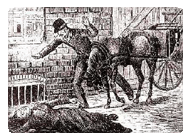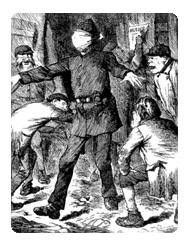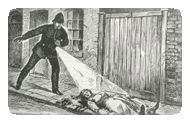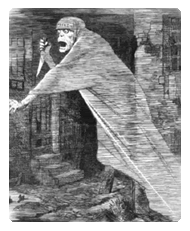Monday, June 27, 2005
Mary Kelly
One of the myriad unanswered questions concerning the Jack the Ripper case is why Mary Kelly was as completely butchered as she was. Was it just that the killer had time to work his evil, and therefore indulged himself? Or was there another motive?
Some writers have gotten close to what I feel is the motive. They say that Mary was the final puzzle of some conspiracy, whether she was the last prostitute involved in a blackmail plot or the last witness of a royal indiscretion. Either way, these are too romantic to be credible. Occam’s razor (apt for Jack) should apply. Mary Kelly was the culmination of a killer’s increasingly rapacious appetite for destruction of the female form. Consider:
Ø Mary Nichols had her throat slit and womb cut.
Ø Annie Chapman’s intestines were taken out and placed on her shoulder after the slitting of the throat and the extraction of the womb.
Ø Liz Stride’s throat was slit, then the killer was most probably interrupted.
Ø Catherine Eddowes’ injuries were the most serious so far, with her being nearly decapitated, her face mutilated and her ears cut. She was the second victim that night.
Ø Mary Jane Kelly’s injuries are too numerous to mention. Suffice to say, the police photographs of the body do not appear to depict anything human.
Robert K. Ressler and John Douglas, two former F.B.I. agents and authors of many books concerning “profiling” serial killers speak about a serial killer’s increasing blood lust and need for heightened experiences and danger in order to assuage their frustrations. Much like a drug-addict must increase the dosage of his drug of choice, the killer must increase the experience in some way in order to achieve the “high” of the first time. This is not a change of modus operandi; rather, it is a modification of an established pattern. I would submit that Jack had an agenda that included not only the murder of the prostitutes but also a systematic heightening of the ways in which the prostitutes were killed. The first victim was killed in a straightforward, almost prosaic way—an outrage in and of itself, but almost lost in a city that had just recovered from the murders of Martha Tabram and Emma Smith. The next, Annie Chapman, was killed and then displayed with her intestines in full view as an increase in horror and to engender more fear of the killer on the part of the populace. The killer then decided to inflict facial mutilations on his next victim as well as more bodily injuries. But he was interrupted in his work. He made sure that Catherine Eddowes received the injuries he planned on, but she was his second victim of the night. This attitude of the killer, that he would succeed at his task no matter the danger, led him to complete the almost unheard-of murder of two separate people in one night.
Therefore, we can speculate that the killer then incorporated the “two in one night” scenario for his next planned outrage. He may have started with the notion that he would kill a woman in her home, not only to claim another victim but also strike more fear in the hearts of the public. No longer would it be the streetwalker that was at risk—those who entertained in their homes were also not safe. How far a leap is it to believe that his next victim after Mary Kelly would not have been of the “unfortunate” class at all? After all, his agenda was to satisfy a frustration building inside him with an increased rage against his victims. How long would the almost too-readily available women of the night continue to satisfy him?
In this scenario, after the “double event,” the killer would have modified his plans to kill a woman in her residence. What if he knew of a certain woman who regularly had other prostitutes stay with her? Wouldn’t this be his dream come true? He had killed two in one night—one woman would not suffice this time in keeping with his method of increasingly brutal murders. The ability to kill two women, and to commit those murders at leisure, would seem perfect for him.
So what went wrong? Joe Barnett had moved out (or Mary had thrown him out, depending upon whom you believe) because Mary had allowed a prostitute to stay in 13 Miller’s Court. The killer knows that Mary has someone there. He chooses to avail himself of the opportunity. He makes sure that Mary still has her houseguest (perhaps he did this when meeting her at the pub, as it has been said that Mary was seen “waiting” for someone outside the Britannia on the night of her death). But when he arrives, Mary is alone. Outraged at being deprived of the next link in his chain, he proceeds to mutilate and savage Mary beyond description. He had to do this for two reasons—because of his anger at her for deceiving him, and to somehow satisfy his growing internal frustrations. Only after he accomplished the horrific injuries on Mary’s body did he feel his calm restored.
This begs the question: Why did he stop? Why was Mary the last if he was not finished with his plan? He may have moved on, perhaps to America, or to a city or town in England. This pattern could fit a lot of the suspects in the Jack the Ripper case, with the possible exception of Druitt. Serial killers do not often commit suicide because of the realization of their crimes or some self-actualization discovered after a killing. Even “Jack the Stripper” of the 70s in London, if the suspect the police had was indeed responsible, committed suicide because the police were closing in on him, not because he finally felt remorse for his crimes. Because of the reports of crimes in and around England after Jack the Ripper, we cannot be sure that he didn’t just move his base of operations.
jack the ripper
Some writers have gotten close to what I feel is the motive. They say that Mary was the final puzzle of some conspiracy, whether she was the last prostitute involved in a blackmail plot or the last witness of a royal indiscretion. Either way, these are too romantic to be credible. Occam’s razor (apt for Jack) should apply. Mary Kelly was the culmination of a killer’s increasingly rapacious appetite for destruction of the female form. Consider:
Ø Mary Nichols had her throat slit and womb cut.
Ø Annie Chapman’s intestines were taken out and placed on her shoulder after the slitting of the throat and the extraction of the womb.
Ø Liz Stride’s throat was slit, then the killer was most probably interrupted.
Ø Catherine Eddowes’ injuries were the most serious so far, with her being nearly decapitated, her face mutilated and her ears cut. She was the second victim that night.
Ø Mary Jane Kelly’s injuries are too numerous to mention. Suffice to say, the police photographs of the body do not appear to depict anything human.
Robert K. Ressler and John Douglas, two former F.B.I. agents and authors of many books concerning “profiling” serial killers speak about a serial killer’s increasing blood lust and need for heightened experiences and danger in order to assuage their frustrations. Much like a drug-addict must increase the dosage of his drug of choice, the killer must increase the experience in some way in order to achieve the “high” of the first time. This is not a change of modus operandi; rather, it is a modification of an established pattern. I would submit that Jack had an agenda that included not only the murder of the prostitutes but also a systematic heightening of the ways in which the prostitutes were killed. The first victim was killed in a straightforward, almost prosaic way—an outrage in and of itself, but almost lost in a city that had just recovered from the murders of Martha Tabram and Emma Smith. The next, Annie Chapman, was killed and then displayed with her intestines in full view as an increase in horror and to engender more fear of the killer on the part of the populace. The killer then decided to inflict facial mutilations on his next victim as well as more bodily injuries. But he was interrupted in his work. He made sure that Catherine Eddowes received the injuries he planned on, but she was his second victim of the night. This attitude of the killer, that he would succeed at his task no matter the danger, led him to complete the almost unheard-of murder of two separate people in one night.
Therefore, we can speculate that the killer then incorporated the “two in one night” scenario for his next planned outrage. He may have started with the notion that he would kill a woman in her home, not only to claim another victim but also strike more fear in the hearts of the public. No longer would it be the streetwalker that was at risk—those who entertained in their homes were also not safe. How far a leap is it to believe that his next victim after Mary Kelly would not have been of the “unfortunate” class at all? After all, his agenda was to satisfy a frustration building inside him with an increased rage against his victims. How long would the almost too-readily available women of the night continue to satisfy him?
In this scenario, after the “double event,” the killer would have modified his plans to kill a woman in her residence. What if he knew of a certain woman who regularly had other prostitutes stay with her? Wouldn’t this be his dream come true? He had killed two in one night—one woman would not suffice this time in keeping with his method of increasingly brutal murders. The ability to kill two women, and to commit those murders at leisure, would seem perfect for him.
So what went wrong? Joe Barnett had moved out (or Mary had thrown him out, depending upon whom you believe) because Mary had allowed a prostitute to stay in 13 Miller’s Court. The killer knows that Mary has someone there. He chooses to avail himself of the opportunity. He makes sure that Mary still has her houseguest (perhaps he did this when meeting her at the pub, as it has been said that Mary was seen “waiting” for someone outside the Britannia on the night of her death). But when he arrives, Mary is alone. Outraged at being deprived of the next link in his chain, he proceeds to mutilate and savage Mary beyond description. He had to do this for two reasons—because of his anger at her for deceiving him, and to somehow satisfy his growing internal frustrations. Only after he accomplished the horrific injuries on Mary’s body did he feel his calm restored.
This begs the question: Why did he stop? Why was Mary the last if he was not finished with his plan? He may have moved on, perhaps to America, or to a city or town in England. This pattern could fit a lot of the suspects in the Jack the Ripper case, with the possible exception of Druitt. Serial killers do not often commit suicide because of the realization of their crimes or some self-actualization discovered after a killing. Even “Jack the Stripper” of the 70s in London, if the suspect the police had was indeed responsible, committed suicide because the police were closing in on him, not because he finally felt remorse for his crimes. Because of the reports of crimes in and around England after Jack the Ripper, we cannot be sure that he didn’t just move his base of operations.
jack the ripper
















Post a Comment
<< Home